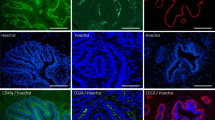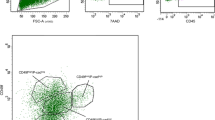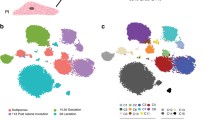Abstract
Milk production is highly dependent on the optimal development of the mammary epithelium. It is therefore essential to better understand mammary epithelial cell growth and maintenance from the related epithelial lineage during the animal life. Here, we characterized the epithelial lineage at puberty, lactation and dry-off in bovine using the cell surface markers CD49f, CD24, and CD10. The pubertal period was characterized by a high proportion of CD49fpos cells corresponding to various epithelial subpopulations, notably the CD24pos subpopulations. The proportion of CD49fpos cells was weaker during lactation and dry-off, and CD24pos cells were relatively few. Of note, the (sub)population profile at dry-off appeared close to that during lactation. Using a targeted gene approach, we associated specific genes with epithelial subpopulations, their expression level varying, or not, according to physiological stages. Caseins were only expressed in the CD49fmedCD24neg subpopulation. Basal marker genes (keratin(KRT)5, KRT14 and αSMA) were found in the CD49fhighCD24neg subpopulations. Luminal gene markers (KRT7, KRT8 and KRT19, CDH1 and the PRLR) were expressed in the CD49flowCD24neg subpopulation. The CD49flowCD24pos subpopulation, only abundant at puberty, expressed luminal gene markers and KI67 at high level. In contrast to others, the CD49fhighCD24pos cells accounted for a small proportion of total cells, decreasing from puberty to dry-off. They were characterized by expression of luminal and basal gene markers and low KI67 level. Interestingly, this subpopulation showed a remarkable stability of gene expression profile throughout physiological stages and bear the hallmark of quiescence that designate them as the potential bovine mammary stem cells.



Similar content being viewed by others
References
Akers RM, McFadden TB, Purup S, Vestergaard M, Sejrsen K, Capuco AV. Local IGF-I axis in peripubertal ruminant mammary development. J Mammary Gland Biol Neoplasia. [Research Support, Non-U.S. Gov't Research Support, U.S. Gov't, Non-P.H.S. Review]. 2000 Jan;5(1):43–51.
Woodward TL, Beal WE, Akers RM. Cell interactions in initiation of mammary epithelial proliferation by oestradiol and progesterone in prepubertal heifers. J Endocrinol. 1993 Jan;136(1):149–57.
Scheele CL, Hannezo E, Muraro MJ, Zomer A, Langedijk NS, van Oudenaarden A, et al. Identity and dynamics of mammary stem cells during branching morphogenesis. Nature. [Research Support, Non-U.S. Gov't]. 2017 Feb 16;542(7641):313–7.
Lee HJ, Ormandy CJ. Interplay between progesterone and prolactin in mammary development and implications for breast cancer. Molecular and cellular endocrinology. [Review]. 2012 Jun 24;357(1–2):101–7.
Watson CJ, Kreuzaler PA. Remodeling mechanisms of the mammary gland during involution. Int J Dev Biol. [Research Support, Non-U.S. Gov't Review]. 2011;55(7–9):757–62.
Capuco AV, Wood DL, Baldwin R, McLeod K, Paape MJ. Mammary cell number, proliferation, and apoptosis during a bovine lactation: relation to milk production and effect of bST. J Dairy Sci. 2001 Oct;84(10):2177–87.
Deome KB, Faulkin LJ Jr, Bern HA, Blair PB. Development of mammary tumors from hyperplastic alveolar nodules transplanted into gland-free mammary fat pads of female C3H mice. Cancer Res. 1959 Jun;19(5):515–20.
Ellis S, Capuco AV. Cell proliferation in bovine mammary epithelium: identification of the primary proliferative cell population. Tissue Cell. [Research Support, U.S. Gov't, Non-P.H.S.]. 2002 Jun;34(3):155–63.
Capuco AV. Identification of putative bovine mammary epithelial stem cells by their retention of labeled DNA strands. Exp Biol Med (Maywood). [Research Support, U.S. Gov't, Non-P.H.S.]. 2007 Nov;232(10):1381–90.
Martignani E, Eirew P, Eaves C, Baratta M. Functional identification of bovine mammary epithelial stem/progenitor cells. Vet Res Commun. [Research Support, Non-U.S. Gov't]. 2009 Sep;33 Suppl 1:101–3.
Osinska E, Wicik Z, Godlewski MM, Pawlowski K, Majewska A, Mucha J, et al. Comparison of stem/progenitor cell number and transcriptomic profile in the mammary tissue of dairy and beef breed heifers. J Appl Genet. [Research Support, Non-U.S. Gov't]. 2014 Aug;55(3):383–95.
Rauner G, Barash I. Cell hierarchy and lineage commitment in the bovine mammary gland. PLoS One. [Research Support, Non-U.S. Gov't]. 2012;7(1):e30113.
Perruchot MH, Arevalo-Turrubiarte M, Dufreneix F, Finot L, Lollivier V, Chanat E, et al. Mammary epithelial cell hierarchy in the dairy cow throughout lactation. Stem Cells Dev. 2016 Oct 01;25(19):1407–18.
Finot L, Chanat E, Dessauge F. Molecular signature of the putative stem/progenitor cells committed to the development of the bovine mammary gland at puberty. Sci Rep. 2018 Nov 1;8(1):16194.
Van Keymeulen A, Rocha AS, Ousset M, Beck B, Bouvencourt G, Rock J, et al. Distinct stem cells contribute to mammary gland development and maintenance. Nature. [Research Support, Non-U.S. Gov't]. 2011 Oct 09;479(7372):189–93.
Rodilla V, Dasti A, Huyghe M, Lafkas D, Laurent C, Reyal F, et al. Luminal progenitors restrict their lineage potential during mammary gland development. PLoS Biol. [Research Support, Non-U.S. Gov't]. 2015 Feb;13(2):e1002069.
Rauner G, Ledet MM, Van de Walle GR. Conserved and variable: Understanding mammary stem cells across species. Cytometry A. [Review]. 2017 Aug 22.
Fu N, Lindeman GJ, Visvader JE. The mammary stem cell hierarchy. Curr Top Dev Biol. [Research Support, Non-U.S. Gov't Review]. 2014;107:133–60.
Sleeman KE, Kendrick H, Ashworth A, Isacke CM, Smalley MJ. CD24 staining of mouse mammary gland cells defines luminal epithelial, myoepithelial/basal and non-epithelial cells. Breast Cancer Res. [Research Support, Non-U.S. Gov't]. 2006;8(1):R7.
Oakes SR, Gallego-Ortega D, Ormandy CJ. The mammary cellular hierarchy and breast cancer. Cell Mol Life Sci. [Review]. 2014 Nov;71(22):4301–24.
Shackleton M, Vaillant F, Simpson KJ, Stingl J, Smyth GK, Asselin-Labat ML, et al. Generation of a functional mammary gland from a single stem cell. Nature. [Research Support, Non-U.S. Gov't]. 2006 Jan 05;439(7072):84–8.
Stingl J, Eirew P, Ricketson I, Shackleton M, Vaillant F, Choi D, et al. Purification and unique properties of mammary epithelial stem cells. Nature. [Research Support, Non-U.S. Gov't]. 2006 Feb 23;439(7079):993–7.
Finot L, Chanat E, Dessauge F. Molecular signature of the putative stem/progenitor cells committed to the development of the bovine mammary gland at puberty. Sci Rep. 2018;submitted.
Safayi S, Korn N, Bertram A, Akers RM, Capuco AV, Pratt SL, et al. Myoepithelial cell differentiation markers in prepubertal bovine mammary gland: effect of ovariectomy. J Dairy Sci. [Research Support, U.S. Gov't, Non-P.H.S.]. 2012 Jun;95(6):2965–76.
Stingl J, Raouf A, Emerman JT, Eaves CJ. Epithelial progenitors in the normal human mammary gland. Journal of mammary gland biology and neoplasia. [Research Support, Non-U.S. Gov't Review]. 2005 Jan;10(1):49–59.
Trejo CL, Luna G, Dravis C, Spike BT, Wahl GM. Lgr5 is a marker for fetal mammary stem cells, but is not essential for stem cell activity or tumorigenesis. NPJ Breast Cancer. 2017;3:16.
Wang D, Cai C, Dong X, Yu QC, Zhang XO, Yang L, et al. Identification of multipotent mammary stem cells by protein C receptor expression. Nature. [Research Support, Non-U.S. Gov't]. 2015 Jan 01;517(7532):81–4.
Ewald AJ, Brenot A, Duong M, Chan BS, Werb Z. Collective epithelial migration and cell rearrangements drive mammary branching morphogenesis. Dev Cell. [Research Support, N.I.H., Extramural Research Support, Non-U.S. Gov't]. 2008 Apr;14(4):570–81.
Deugnier MA, Moiseyeva EP, Thiery JP, Glukhova M. Myoepithelial cell differentiation in the developing mammary gland: progressive acquisition of smooth muscle phenotype. Dev Dyn. [Research Support, Non-U.S. Gov't]. 1995 Oct;204(2):107–17.
Capuco AV, Akers RM. Mammary involution in dairy animals. J Mammary Gland Biol Neoplasia. [Review]. 1999 Apr;4(2):137–44.
Pelissier FA, Garbe JC, Ananthanarayanan B, Miyano M, Lin C, Jokela T, et al. Age-related dysfunction in mechanotransduction impairs differentiation of human mammary epithelial progenitors. Cell Rep. [Research Support, N.I.H., Extramural Research Support, Non-U.S. Gov't Research Support, U.S. Gov't, Non-P.H.S.]. 2014 Jun 26;7(6):1926–39.
Berryhill GE, Trott JF, Hovey RC. Mammary gland development--It's not just about estrogen. J Dairy Sci. [Research Support, N.I.H., Extramural Research Support, U.S. Gov't, Non-P.H.S. Review]. 2016 Jan;99(1):875–83.
Akers RM. A 100-year review: mammary development and lactation. J Dairy Sci. 2017 Dec;100(12):10332–52.
Lollivier V, Lacasse P, Angulo Arizala J, Lamberton P, Wiart S, Portanguen J, et al. In vivo inhibition followed by exogenous supplementation demonstrates galactopoietic effects of prolactin on mammary tissue and milk production in dairy cows. J Dairy Sci. 2015 Dec;98(12):8775–87.
Tong JJ, Thompson IM, Zhao X, Lacasse P. Effect of 17beta-estradiol on milk production, hormone secretion, and mammary gland gene expression in dairy cows. J Dairy Sci. 2018 Mar;101(3):2588–601.
Faure E, Heisterkamp N, Groffen J, Kaartinen V. Differential expression of TGF-beta isoforms during postlactational mammary gland involution. Cell Tissue Res. [Research Support, Non-U.S. Gov't Research Support, U.S. Gov't, P.H.S.]. 2000 Apr;300(1):89–95.
Wu A, Dong Q, Gao H, Shi Y, Chen Y, Zhang F, et al. Characterization of mammary epithelial stem/progenitor cells and their changes with aging in common marmosets. Sci Rep. 2016 Aug 25;6:32190.
Garbe JC, Pepin F, Pelissier FA, Sputova K, Fridriksdottir AJ, Guo DE, et al. Accumulation of multipotent progenitors with a basal differentiation bias during aging of human mammary epithelia. Cancer Res. [Research Support, N.I.H., Extramural Research Support, U.S. Gov't, Non-P.H.S.]. 2012 Jul 15;72(14):3687–701.
Prater MD, Petit V, Alasdair Russell I, Giraddi RR, Shehata M, Menon S, et al. Mammary stem cells have myoepithelial cell properties. Nat Cell Biol. 2014 Oct;16(10):942–50 1-7.
Acknowledgements
This work was supported by the Animal Physiology & Livestock System Department of the French National Institute for Agricultural Research (INRA). We thank Laurent Deleurme and Gersende Lacombe from the CytomeTRI platform as well as Marine Biget from the GEH platform of the BIOSIT core facility at Rennes (France) for technical assistance. Acknowledgements are also extended to the staff at the INRA dairy farm of Méjusseaume (UMR1348 PEGASE, Le Rheu, France); Sandra Wiart and Frédérique Mayeur-Nickel for laboratory analyses and Rémi Resmond for technical assistance in statistics.
Author information
Authors and Affiliations
Contributions
L. Finot and F. Dessauge designed and conceived experiments, L. Finot performed experiments, assemblied and analysed data. L. Finot, E.Chanat and F. Dessauge collaborated to the data interpretation. The three authors collaborated equally on the writing of the manuscript and its final approval.
Corresponding author
Ethics declarations
Conflict of Interest
We declare no conflict of interest, no competing financial and non-financial interests
Additional information
Publisher’s Note
Springer Nature remains neutral with regard to jurisdictional claims in published maps and institutional affiliations.
Electronic supplementary material
Figure S1
Populations of cells in the bovine mammary tissue highlighted by the expression of the surface proteins CD49f, CD24 or CD10 in flow cytometry. Dissociated cells from the mammary tissue of lactating and dried cows were stained with either anti-CD49f–FITC (CD49f), anti-CD24-APC (CD24) or anti-CD10-PE Vio770 (CD10) antibodies and analyzed by flow cytometry. Each gating shows the positive cells. Abbreviation: SSC, Side Scatter light (PDF 239 kb)
Figure S2
Sub-populations of epithelial cells in the bovine mammary epithelium highlighted by the co-expression of surface proteins CD49f, CD24 and CD10 in flow cytometry. Dissociated cells from the mammary tissue of lactating and dried cows were co-stained with either anti-CD49f-FITC and anti-CD10-PE Vio770 antibodies, or anti-CD10-PE Vio770 and anti-CD24-APC antibodies, and analyzed by flow cytometry. Each gating shows the positive cells; positive cells are located to the right of the gating on the x-axis and above the gating on the y-axis. Sub-populations of epithelial cells were distinguished according to the intensity of the cell surface marker expression (low vs. high). Abbreviation: SSC, Side Scatter light (PDF 218 kb)
Table S1
(PDF 220 kb)
Table S2
(PDF 85.9 kb)
Table S3
(PDF 185 kb)
Rights and permissions
About this article
Cite this article
Finot, L., Chanat, E. & Dessauge, F. Mammary Epithelial Cell Lineage Changes During Cow’s Life. J Mammary Gland Biol Neoplasia 24, 185–197 (2019). https://doi.org/10.1007/s10911-019-09427-1
Received:
Accepted:
Published:
Issue Date:
DOI: https://doi.org/10.1007/s10911-019-09427-1




